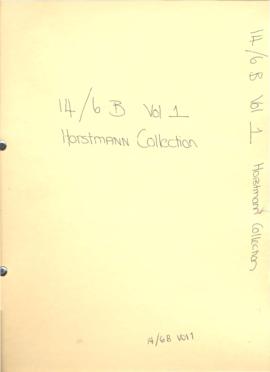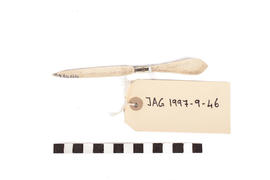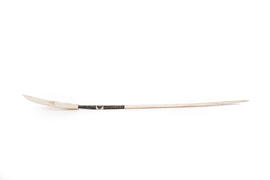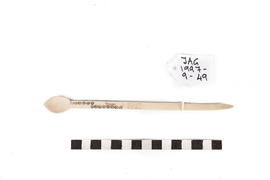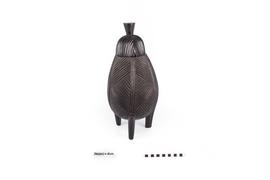- Attributions and conjectures
[Source - Maritz, N.G. Relics of War: A Collection of 19th Century Artefacts from British South Africa and Southern Rhodesia. Pretoria: Salut Africa CC, 2008, used without alteration by JAG, 2015: JAG Description: Vessel with lid as drinking cup, North Nguni, 19th Century]
Physical characteristics
[Source - Maritz, N.G. Relics of War: A Collection of 19th Century Artefacts from British South Africa and Southern Rhodesia. Pretoria: Salut Africa CC, 2008, used without alteration by JAG, 2015: Dimesions: 43,5 x 20,5 x 20 cm (pot and lid) 12,5 cm (height of lid) Material: Wood and pokerwork (Strictly speaking pokerwork is a technique. ‘Carved’ should be added. (Info supplied by C. Elliott Weinberg, 18 Nov 2014)]
Attributions and conjectures
[Source - Nessa Leibhammer for FHYA, 2015: Acquired from: Maritz bought this vessel from Kevin Conru an American dealer of African and Oceanic art based in the UK and in Brussels. Conru was previously the head of the African and Oceanic Departments of Bonham’s auction house. Now a private dealer, he has assembled an important collection of early Southern African art. See Conru, K., Klopper, S and Nel, K. 2002. The Art of Southeast Africa from the Conru Collection. (Information provided by Karel Nel, 12 October 2014).]
Attributions and conjectures
[Source - Nessa Leibhammer for FHYA, 2015: Object notes: While one of these vessels is on the front cover of the first major publication on southern African traditional art, the 1991 Art and Ambiguity: Perspectives on the Brenthurst collection of Southern African art there is no mention of them in the texts. The provenance of these vessels remain unclear. Although they have been called ‘beer’ or ‘milk’ vessels there are no traces of liquid residues. Karel Nel has suggested they may have been used to hold snuff (personal communication, November 2014). They have been attributed to both Swazi and Zulu origins. However Elliot Weinberg has identified a “a renowned artisan, named Unobadula…who live[d] upon the Ixeku [Mqeku] river a tributary of the Umgeni [Mngeni]” who supplied three to the Natal Court at the 1862 International Exhibition in London (Elliott-Weinberg 2015 forthcoming). See image of object on BM accession slip and UKZN Killie Campbell Collections photograph of the carver. Although Nettleton and Dell also mention Unobadula, Elliot is the only one to have linked him to the five works mentioned in Mann’s catalogue for the 1862 Empire Exhibition. Her further contribution is the identification of him as sitter in the Campbell Collections photograph (also by Mann).]
Attributions and conjectures
[Source - Nessa Leibhammer for FHYA, 2017: Comments on classification: In his ‘A Preliminary Survey of the Bantu Tribes of South Africa’, Union of South Africa, Department of Native Affairs, Ethnological Publications, Vol. 5, Pretoria, Government Printer, (1935): 7, 70-83, national government ethnologist, Nicholas Van Warmelo did not use the term “North Nguni”. He grouped people living both north and south of the Thukela, under one umbrella term, “Natal Nguni”, based on linguistic affinity. His classification was adapted by the ethnology curator, Margaret Shaw, in her 1958 “System of Cataloguing Ethnographic Material in Museums” which determined that items from the region were to be classified as “Natal Nguni: Zulu and others (not differentiated).” According to art historian, Anitra Nettleton, the classificatory system used by art galleries and museum shifted from Shaw’s model to the one where “Natal Nguni” fell away and was replaced by “North/Northern Nguni” for KwaZulu-Natal and Swaziland because scholars found it difficult to distinguish items from adjacent areas, or emmigrant people from those from the KZN region. Scholars working with the JAG materials used broad ethno-linguistic categories (Zulu, Xhosa, Tsonga, Shona, Sotho, Tswana) to identify the makers/users of the objects, all of which came to JAG without much by way of provenance, and identification was based on factors such as object type, materials, formal composition, style and surface patterning (emails A. Nettleton to N. Leibhammer, 25 and 28 November 2014).]


